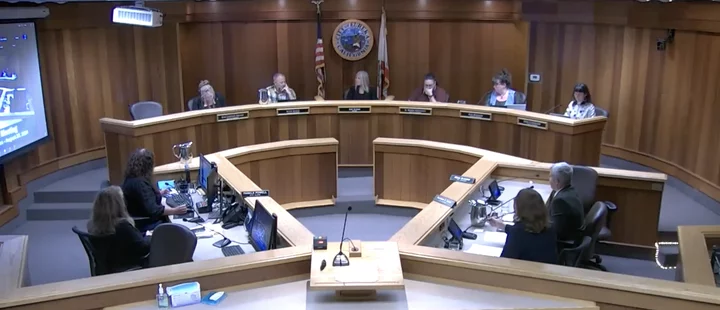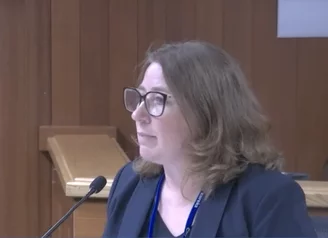Screenshot of Tuesday’s Eureka Council meeting.
On Tuesday, the Eureka City Council introduced a Vacant Building Ordinance that aims to discourage property owners from neglecting residential and commercial buildings long-term.
If approved, the ordinance will allow the city to collect a fine of $1,000 per month for every building left vacant for more than 90 days, with some exceptions. After a year, the fine jumps to $5,000 per month. (The first draft of the new rules set that vacancy window at 30 days, but the council extended the timeline on Tuesday after some discussion). The ordinance also outlines a maintenance and monitoring program requiring property owners to keep empty buildings lookin’ spiffy pending occupation. It’s a more heavy-handed policy than the city’s current code for vacant building upkeep.
The ordinance lists several problems associated with empty and neglected buildings: they spread blight, create fire risks, depreciate neighboring property values and discourage economic development. Filling vacant buildings will strengthen Eureka’s neighborhoods and address the housing shortage, the document reads.
There are a couple of exceptions written into the ordinance. If the owner is diligently working on permitted repairs, rehabilitation or demolition, they won’t have to pay up. Property owners also won’t be fined if they’re actively looking to sell, lease or rent the property “in good faith.” There is some forgiveness baked into the rules for those experiencing a hardship.
Meanwhile, the monitoring program element of the ordinance would require property owners to submit a “vacant building plan” explaining how long their building will be vacant and why. During that time, property owners are expected to upkeep buildings’ landscaping and exterior appearance and clear away trash and graffiti. The city will monitor vacant buildings quarterly – and collect a monitoring fee – for the duration of the vacancy.
Tuesday was the council’s second look at the proposed rules, which have been a little tricky to nail down. The council took a first peek during its Aug. 6 meeting but decided to table the item after requesting some changes (council members Scott Bauer and Kati Moulton were absent from that discussion). Tuesday’s draft had an updated definition of “vacant building” to include individual units, with intent to prevent people from sidestepping the rules by filling just one of many vacancies in a multi-unit building.
At Tuesday’s meeting, council members weighed how to achieve the goal of the ordinance – making best use of the city’s buildings – without too heavily punishing property owners and burdening city staff with time-consuming enforcement efforts.
During public comment, Scott Pesch, a local commercial real estate broker, said he and his clients are concerned about the punitive approach and subjective language of the ordinance.
“You have to understand that landlords and property owners have the same incentive that the city has in respect to getting things leased up and bringing in some income,” Pesch said. “I think that we have to be careful with penalizing landlords for vacancies. I think that we have to realize that these are a little subjective, okay, and it’s a little bit of a slippery slope.”
Pesch said that vacancies are often not due to higher-than-reasonable rent prices; there just isn’t enough demand for some types of rental units. The county’s existing code for vacant buildings does the trick, he added.
Some council members echoed those concerns, worried the ordinance could exacerbate community members’ struggles during an economic downturn. Noting she’d just learned of five downtown businesses closing, Councilmember Renee Contreras-DeLoach said the timelines and fees made her feel “squeamish.”
“I don’t love the timelines,” she said. “I’m concerned about that, and I’m concerned about taking punitive action when I think that the economy is flagging.”
Others agreed that the timelines are short considering the intention of the ordinance.
“I agree that these timelines should be extended. From what I see – working in Old Town, walking around a lot – to me, the problem is long-term vacancies,” said Councilmember Bauer, referencing buildings he’s seen left empty for years at a time.
“How is that possible? I want to understand – is there tax reasons, or what are people doing to keep these things vacant for so long? So I don’t see the issue being a 30 day vacancy or 60 day vacancy, I see a year. So I’m more inclined to say, why not 90 days or 120 days? Because the issue is these long-term situations that we see.”
City Attorney Autumn Luna said that 30 days of notice is pretty standard, and maybe even more lenient than normal. The original draft had an even shorter window of 15 days before the Economic Development Commission suggested extending it, Luna said – but changing it again would be “no problem,” she told the council.
The council ended up extending the notice deadline from 30 days to 90 before the monthly $1,000 fine kicks in, and doubled most other timelines spelled out in the ordinance. Staff will add “in good faith” to the section of the policy exempting those trying to rent or sell their property, and will update the definition of “owner” to prevent LLCs from gaming the system.
The council passed a motion to introduce the ordinance with those amendments 3-2, with council members G. Mario Fernandez and Contreras-DeLoach dissenting. The ordinance will come back to the council for adoption at a future meeting.
###
What else happened at Tuesday’s meeting?
- The Council approved of a lot line adjustment and the vacating of parts of S and Front Streets to free up space for a proposed resort RV Park near Halvorsen Park on Waterfront Drive.
- The Council received a presentation about creating an EIFD, or Enhanced Infrastructure Financing District, which would redirect property tax increment revenues from a specific geographical area for city projects. Creating an EIFD takes more than a year, and benefits take even longer to kick in.
- The Council voted to approve the design of a five-plex on Buhne Street, which has been fought fiercely by neighbors of the project.


CLICK TO MANAGE